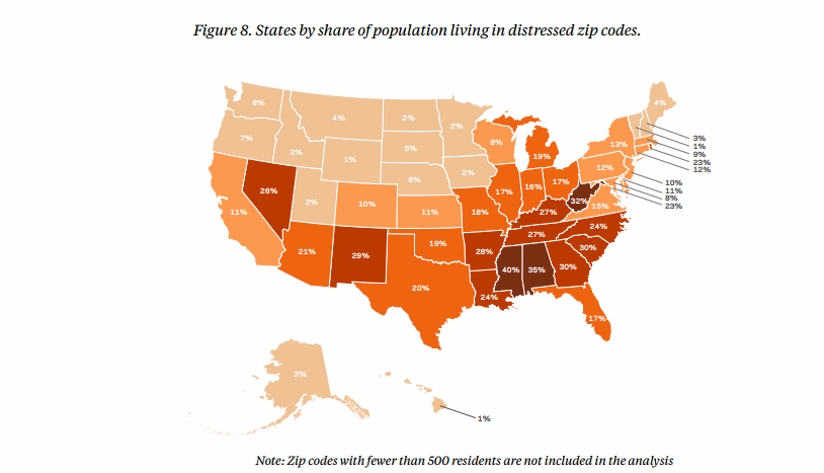Milwaukee’s Economic Challenge
A new study shows Milwaukee is among the ten most distressed cities. Is it accurate?
Question: Can the bright minds of Silicon Valley provide any guidance for cities like Milwaukee, which have been largely left far behind by the high tech hot spots of America?
A new group called the Economic Innovation Group (EIG) was launched last year, based in Washington D.C., with an impressive bipartisan staff and board, whose goal is to craft centrist proposals to stimulate the economy and press Congress to enact them. The hard part will be getting Congress to pass anything, but in the meantime the EIG has released a study that’s intended to define the problem: a detailed data analysis of the nation’s economy by state, region and city that got considerable coverage in the New York Times. The results are pretty dreadful for Milwaukee.
The study confirms what other information has suggested, that the nation’s recovery from the Great Recession hasn’t lifted all boats. Polls in the last two years have found the majority of people still thought the economy was in a recession, as the Times story noted. The new study found the gap between richer and poorer communities actually widened during the recovery. “The country’s top zip codes,” the report found, “are in the midst of an economic boom.” But “the most distressed 10 percent of zip codes lost 13 percent of their jobs and saw more than one in 10 business establishments close…The recovery gap stands out as particularly urgent and alarming because it suggests that well-being will continue to worsen for residents of locales that are locked in a downward spiral.”
The study set an ambitious goal, to use Census Bureau data from 2010 through 2014 to analyze 26,000 zip codes and over 3,000 counties as to the percent of adults with a high school degree, percent working, home vacancy rates, percent of people below the poverty line, median income as a percent of the state average, changes in employment and in the number of businesses. It then used those criteria to create a “distress score” and ranked those zip codes whose score falls in the highest 20 percent of its peer group, meaning its more distressed than 80 percent of zip codes.
The approach strikes me as unique, and because it’s not based just on one or two criteria, could become a valuable way to target those areas of the country most in need of help. On the other hand, it uses the Census Bureau’s American Community Survey data, whose sampling data can sometimes be problematic in tracking year-to-year trends.
Still, the study’s general picture of the country’s most distressed zip codes is likely accurate, and what it found is that these areas “are stuck in a deep recession, while the most prosperous flourish.”
There was good news for Wisconsin. In the average state 15 percent of the population lives in distressed zip codes, the study found, compared to just eight percent in Wisconsin. This state’s percent living in distressed zip codes was considerably lower than the comparable figure in Michigan (19 percent), Illinois (17 percent) and Indiana (16 percent) but well above Iowa and Minnesota (both at just two percent).
The distressed zip codes were heavily concentrated in the South, but also in the Rust Belt cities of the northeast and Midwest “and California’s Central Valley or Inland Empire,” the study noted. “A common feature unites this geographically diverse group: Each has struggled to transition from an economy based on legacy industries (often manufacturing) to a more advanced, knowledge-based one. Such cities include Buffalo, Cleveland, Milwaukee, and Winston-Salem.”
Yes, Milwaukee ranked among the 10 most distressed big cities, at 8th worst in the portion of population (54 percent) living in distressed zip codes. Detroit was the worst at 99 percent living in distressed zip codes, Cleveland second at 77 percent, while San Francisco was the least distressed, with just four-tenths of one percent of the population living in a distressed zip code!
The Times was able to get some unique data from the study that broke down all seven criteria for the ten worst cities here. Milwaukee in this analysis ranked seventh worst, with low marks in the growth of businesses and jobs dragging it down.
Using this data, you can compare Milwaukee to the nation’s median zip code and you find 18 percent in this city lacked a high school diploma, compared to 12 percent in America’s median zip code, 29 percent below the poverty line compared to 13 percent nationally, 44 percent of adults not working (43 percent nationally), an 11 percent housing vacancy rate (8 percent national median), 67 percent in Milwaukee at the median state income compared to 94 percent nationally, a 1.2 percent decline in employment versus 2.3 percent national median growth, and a 2.9 percent decline in number of business establishments, versus no change in the national median zip code. What particularly stands out for Milwaukee is the poverty rate and lack of business and employment growth.
It’s instructive to compare Milwaukee’s economy to Madison’s: “Prosperous large cities tend to be the familiar hubs of the knowledge economy,” the study notes, “cities that specialize in innovation-intensive, technology-based, and high end services industries such as Austin, Madison, Raleigh, San Diego, San Jose, and Seattle.”
Indeed, Madison is a shining star: “Very few large U.S. cities combine high levels of prosperity with low levels of spatial inequality,” study found. The nine that do include Madison, along with places like Arlington VA and Scottsdale, AZ.
The study’s concept of “spatial inequality” is new and provides an alternative to the “dissimilarity index” used by sociologists to measure segregation, which often labels Milwaukee as among the most segregated in America. (And which I’ve suggested is simplistic and misleading.) Rather than simply looking at how well-scattered African Americans are within a metro area, as the dissimilarity index does, this study looks at the distribution of all the distressed population.
The results show Milwaukee is not among the 10 cities with most spatial inequality, a negative ranking led by San Antonio, Atlanta and Fort Worth, Texas. Nor is Milwaukee County among the 10 counties with the most spatial inequality, led by Shelby County TN, including Memphis; Wayne County, MI, including Detroit; and Fulton County GA, including Atlanta.
But “at the metropolitan scale, Indianapolis, Jackson, Las Vegas, and Milwaukee all emerge as some of the most spatially unequal places in the country.”
This strikes me as a far more accurate portrait of Milwaukee’s metro area. The charge of being the most segregated city inevitably prompts discussion of divisions within the city proper. The reality is that Milwaukee has by far the largest population of people of color in Wisconsin. By far the biggest divisions in race and income are not within this city, but between Milwaukee and its surrounding three counties, where zoning restrictions keep out low-income people of any color.
Meantime, this study is a sobering look at the economic challenge facing cities like Milwaukee, with a high percentage of distressed zip codes. “Once distress sets in,” the study notes, “it seems to persist: even the country’s most dynamic and successful cities struggle to achieve geographically equitable prosperity.”
The study echoes a host of findings suggesting the nation’s people are increasingly polarized and separated both economically and politically. Cities have traditionally been the places with the most density and diversity and the renaissance in downtowns and older city areas occurring in Milwaukee and many other American cities offers hope that things can and are improving. This study, however, strongly suggests a national strategy may be needed to bring real hope to distressed areas.
Murphy's Law
-
Is Legislature Biased Against Working Class?
 Apr 4th, 2024 by Bruce Murphy
Apr 4th, 2024 by Bruce Murphy
-
Associated Press Will Decline in Wisconsin
 Mar 27th, 2024 by Bruce Murphy
Mar 27th, 2024 by Bruce Murphy
-
City Attorney Race Is Vitally Important
 Mar 25th, 2024 by Bruce Murphy
Mar 25th, 2024 by Bruce Murphy
















Maybe this will get us off the constant harping of race inequality in this country and start talking about socio-economic issues.
Manufacturing needs to come back to the states. Globalization will continue to destroy working class cities like Milwaukee.
Bringing back manufacturing on a large scale would help, but Wisconsin & Milwaukee already have well-above average amounts of manufacturing jobs.
Manufacturing is being automated away.
This may be a bit off topic. I understand that its easier said than done, but why don’t people go where the jobs are? Do we really expect big companies to start opening factories and other facilities in our central cities? If statistics are true that Milwaukee’s African American neighborhoods have 20%-30% unemployment and 50%+ unemployment for teens and twenty somethings……, why do they stay? It seems to me that it would be FAR easier to shift populations to areas that need employees rather than building 30 factories in the central city.
The African Americans that leave are the educated ones, leaving a largely helpless population behind. Yet all we hear is Milwaukee doesn’t do enough for poor minorities. I know racism exists, and I’m not making light of difficult circumstances. However, please don’t wait for a DC think tank to come riding to the rescue. You’ll be waiting generations.
All the cities mentioned, the prosperous ones, are places where there is a major research university.
Not so with Milwaukee.
I think a major research university would certainly help, but would it fix the legacy of deindustrialization? I’m not sure I would agree.
On the question of a major research university, by one standard definition UWM already is one (as it is now classified in the highest tier of research universities by the Carnegie Classification). But clearly UW-Madison is an elite research university in a way that UWM is not.
I think it’s important to understand that to a large extent the relative standing of UW-Madison and UWM is a political decision. I don’t necessarily mean political in the sense of the state’s level of funding for the whole UW system, though obviously that’s an important piece too. I mean that the UW system itself chooses to support UW-Madison at a far higher level per enrolled student than UWM. Also, assuming that most private donations originate in-state, Wisconsinites choose to give a lot more private money to Madison than to UWM. These politics are hard to change, even if change would ultimately be a net positive for the state due to disproportionate positive impact on the state’s largest metro area.
Of course UW-Madison’s long history as a great research university and its sheer size are meaningful, so that even if funding were equalized tomorrow UWM’s status would not equal Madison’s for a long time. But I don’t think there is a general recognition of how much of the gap is simply a matter of money, rather some “special sauce” that Madison has but UWM does not.
I’m no expert on the effects of universities on local economies, so I don’t know if the research university explanation holds water. But if this is an important aspect of inequality or other parts of Milwaukee’s situation, positive steps are far easier than for problems like deindustrialization or social conditions in the inner city: UWM is already there and doing well, and to be a truly major research university just needs more resources directed to it. As noted, however, the politics (again not necessarily meaning anything about Rep vs Dem, or Scott Walker, or …) make that hard to carry out.
Very thought-provoking report, Bruce.
David, Re: “why don’t people go where the jobs are? Do we really expect big companies to start opening factories and other facilities in our central cities?”
I think there may be many reasons why job seekers are not more mobile. Sometimes it “takes money to make money,” even just to find a job in one’s own town, much less in any other that entails a potentially costly move. One reason some people move around, esp. young people, is that their skills etc. are sought-out and an employer may even help cover their move.
There’s also issues of family and support networks, which can be lost in a move. There’s also issues of who you know and how much you have traveled, including to attend school. Some African Americans I know have barely spent time in some parts of the city, to say nothing of a whole new city.
But a key issue is that even if businesses do not plunk down a factory or whatever in the central city, some jobs might as well be in another metro area considering the lack of convenient transportation. That goes for business parks in New Berlin or other suburbs. There are plenty of other factors at play, but it seems we are not doing a very good job of addressing the issue of connecting people to jobs as a metro area.
There are at least two more factors that limit where unemployed, especially black unemployed, will go for jobs. One is that “the Community” supports its own and expects loyalty in return. The support leads to a sense of belonging, comfort, and social safety. But the other side of the coin is that Community youth are chastised for leaving their family, Church, friends, and neighbors behind.
Another factor is that communities with jobs lack places low income earners can afford to live, and zone against multiple unrelated people sharing an apartment. This may or may not be racially motivated, but it has the effect of keeping the largely-black poor out.
It may be the best thing would be to encourage our unemployed to go wherever the jobs are, including other cities, if need be. The roots of large black populations in Rust Belt cities go to the deep South — people who moved North to find jobs in the factories in Detroit, Toledo, Cleveland, Chicago, and Milwaukee, especially during WWII and the decade after. I don’t see a similar willingness of large numbers to migrate now.
Hoping for the return of mega-manufacturing plants is unrealistic. It takes far fewer people to make a widget today than 5 years ago, much less 20 or 30 years ago, and that trend is likely to continue. The next Industrial Revolution will be in the bio-sciences, combining biology, chemistry, nano-materials, computerization, and 3D small lot custom printing. We’ll need deep research institutes to get such industries started, and a completely revamped educational system to develop and train people to work in the resulting businesses. We’ll need to make STEM the default, not the program solely for those with special interest or abilities, and we’ll need to teach adaptability and entrepreneurship as never before.
Hmm, no WCD posting. In a preemptive post from http://www.jsonline.com/business/laacke–joys-redevelopment-project-to-include-riverfront-restaurants-b99678402z1-370516121.html article on changes for the old Laacke & Joy building on N. Water St. This quote jumped out at me. “All of the project’s prospective office tenants are suburban firms that want to be downtown to better attract employees who are millennial generation members, Wangard said.”
How many of the ten most distressed cities are in States controlled by Republican Governors?
Dave says — ” If statistics are true that Milwaukee’s African American neighborhoods have 20%-30% unemployment and 50%+ unemployment for teens and twenty somethings……, why do they stay? It seems to me that it would be FAR easier to shift populations to areas that need employees rather than building 30 factories in the central city.”
What you are talking about are the manufacturing plants in the surrounding counties, and as Bruce wrote, they are doing their best of keep poor people out.
Of course we could provide transportation options. Pittsburgh and Salt Lake City have mass transit that goes out into the suburbs. Try suggesting that.
What we need is a change in our state government, which is doing everything it come to cripple Milwaukee.
Democrat for governor = Stockton & San Bernardino, CA and Buffalo
Republican for governor = Milwaukee, Detroit, Memphis, Newark, Cleveland, Toledo, and Cincinnati.
What do you expect? Run by white, male, liberal, racists for the last 100 years, Socialist in White house, Doyle at state???
Milwaukee has run all the businesses out of Milwaukee to Waukesha. Instead of fixing problems like crime, heroin, bad management, MPS, roads, we buy arenas, trolleys, Domes.
Have been writing political columns in newspapers for 50 years, watched West Allis rebuild, Rosa row and Milwaukee disintegrate. People like Bruce Murphy run this place. Any other questions???
These are great comments. I am for improved, regional transit and I fully understand social dynamics that keep people in their communities. However, I do not believe the regional economy could support, or even come close to supporting the unemployed and underemployed in our area. I wish it could and I wish the region was more supportive and dynamic. We could have the moral debate about segregation, low income housing, etc, but that’s all it would be. We’ve always been a mobile society and the fact that we have had multiple generations of isolated, dysfunctional populations is problematic.
I’m just offering a twist to the normal conversation. My thinking around this is changing. For example, if someone in that situation asked me for advice, I wouldn’t tell the person to wait for affordable housing in Waukesha or regional transit. I would tell them to pack up and go where the jobs are. Meanwhile, I would work for those changes.
This is going to take out of the box thinking and a willingness not to be tied down by ideology, but to come up with real solutions.
For example. Look around Milwaukee, or any other big city. There is a lot that needs doing. Clean up the neighborhoods. Child care for working parents. Infrastructure.
The solution doesn’t have to be just government, but a private/public partnership.
These don’t have to be forever jobs, but should be tied in with training and education, based on the needs of the economy.
Yup, higher taxes would be involved. But that money which the top incomes for the most part ship out of the state would be used right here, and consequently the whole economy could become stronger.
David,
I agree there are few solutions that can be easily scaled up. There already is a “brain drain” of higher-educated blacks leaving Milwaukee, partly because many feel it’s not a welcoming place for middle-class blacks.
As for overall mobility, one reason MKE’s African American community struggles more than in some northern cities is that their migration here happened later, in the ’50s and ’60s. There was not enough time to build a significant middle class before de-industrialization started wiping it out. Also, housing policy had made it hard to be mobile within most of MKE.
But education is crucial–and we can all help to play a role in that in various ways. And that includes making sure that schools are sufficiently resourced, that students can engage in arts and sports programs as they do in the suburbs, etc.
David’s comment about ‘moving where the jobs are’ is both correct AND wrong. I’ve chased jobs around the country because Milwaukee doesn’t have decent employment in my field, and in fact Milwaukee never had full employment for the baby-boomers anyway, which resulted in the brain-drain starting way back in the 70’s.
The problem is, you have to have an immediately marketable skill, and about 10 grand to do it every time you do! You can’t just get in your car, drive around, and ask for work, this isn’t the 30’s! You have to research and find a city that may have the type of jobs you need. When you’ve found that city, you have to try and rent an apartment there without a job, while also paying on your apartment where you live now. You have to have someplace to forward your mail to, and you have to have a set street address, not a P.O. Box, to get your bank account transferred to. Then you have to go back and forth between the cities, closing your old apartment down, while also looking for employment in your new city. I can also list about ten other things you have to wrangle with while doing this (moving your furniture, transferring insurance, taking drivers tests again); I’ve done it 4 times in my adult life, and it is no where as easy to do as the right-wing pundits make you think it is.
Truth is, moving to find work is for the young or people who have nothing left to lose and are sleeping on the floor in the middle of an empty apartment. The idea that a person with a lower middle class manufacturing job with little savings is going to do this is pure ridiculous.